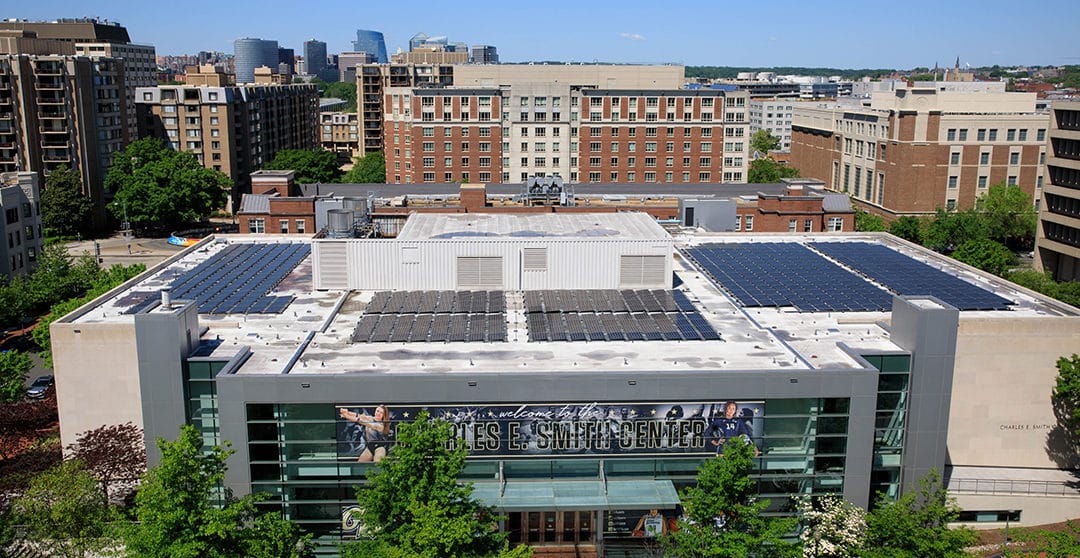In the midst of the Covid-19 pandemic, a new solar project in Washington, D.C. has been designed to stretch the concept of community solar to include what the developers are calling “community benefits.” In this case, the 497-kW project — spread over the rooftops of five buildings at George Washington University (GW) — will cut the school’s carbon emissions and electric bills, help area residents struggling to keep the lights on and support nonprofits fighting homelessness in the city.
Called the Neighborhood Solar Equity project, the new installations at GW are the result of a public-private partnership under D.C.’s innovative Solar For All program, which is putting PV panels on rooftops and other urban in-fill locations around the city. The program was founded in 2016 with the goal of cutting energy bills in half for 100,000 low- and moderate-income (LMI) residents, while adding 10 MW of new solar to the city’s efforts to completely decarbonize its electricity system by 2032.
The GW project aims to generate $1.50 in benefits for every dollar’s worth of electricity the panels produce for the university under a 15-year power purchase agreement. What makes the equation work is D.C.’s active and lucrative market for solar renewable energy credits (SRECs), says Sam Walker, vice president of finance at New Columbia Solar (NCS), which owns and operates the installations.
GW buys the power, but NCS keeps and sells the SRECS to fund the community benefits, which will be split three ways. Half will go to cut utility bills for LMI residents, with another 15% earmarked for emergency assistance to households facing power shutoffs. The final 35% will go to area nonprofits focused on solutions to homelessness in the city.
The percentages for each benefit category will be evaluated and adjusted as conditions change, said Laura Recchie, president of Root & Branch, a benefit corporation that helped put the project together.
“Covid, for instance, is really increasing the number of utility shutoffs across America,” Recchie said. “Energy costs are going up, energy usage is going up because we all have to stay home, so I would not be surprised if, in the next couple years, helping people meet that specific pain point is where we’re getting a lot of traction.”
More than enough profit to share
The original impetus for Neighborhood Solar Equity centered on “how to create projects that create a shared value for neighborhoods,” Recchie recalled. “What would happen if you didn’t want to, if you didn’t have to keep all the profit. We were looking at the solar model in general. just realizing that (with the SRECS) in D.C., there is more than enough profit to share.”
Root & Branch took the idea for such a model to Community Renewable Energy, a solar developer focused on increasing access to solar for nonprofits and LMI communities. At about the same time, GW was exploring options to increase renewables at its D.C. campus and agreed to host the project.
A proposal for the project was among the first group of Solar For All installations approved by the D.C. Department of Energy and the Environment. NCS, a D.C. installer transitioning into project development, also came on board, providing the private side of the public-private funding, along with its expertise in doing commercial-scale projects in the city.
At present, three of the five projects are online, with two more awaiting final commissioning, Walker said. Annual output from the project is estimated at 660 MWh, which will provide about $100,000 in community benefits per year, while cutting GW’s carbon emissions by 450 metric tons per year, the equivalent of taking 100 cars off the road. The money will be distributed to individual recipients and organizations quarterly, with the first payouts tentatively scheduled for October, Recchie said.
But the innovative spirit behind the project has hit a few bumps as a result of the Covid pandemic. For example, at this point, getting residents signed up to receive the bill credits from the project is running behind schedule after social distancing requirements in D.C. sidelined plans for a wide-ranging public outreach and education campaign.
Instead, Root & Branch is looking to partner with affordable housing owners — especially those with properties for low-income senior residents — to help spread the word, Recchie said. When it’s safe to do so, she hopes to restart “the more person-to-person engagements, bringing in folks to discuss renewable energy, environmental justice, energy equity — topics that really help people connect to why solar in a community is a benefit.”
This content is protected by copyright and may not be reused. If you want to cooperate with us and would like to reuse some of our content, please contact: editors@pv-magazine.com.








By submitting this form you agree to pv magazine using your data for the purposes of publishing your comment.
Your personal data will only be disclosed or otherwise transmitted to third parties for the purposes of spam filtering or if this is necessary for technical maintenance of the website. Any other transfer to third parties will not take place unless this is justified on the basis of applicable data protection regulations or if pv magazine is legally obliged to do so.
You may revoke this consent at any time with effect for the future, in which case your personal data will be deleted immediately. Otherwise, your data will be deleted if pv magazine has processed your request or the purpose of data storage is fulfilled.
Further information on data privacy can be found in our Data Protection Policy.